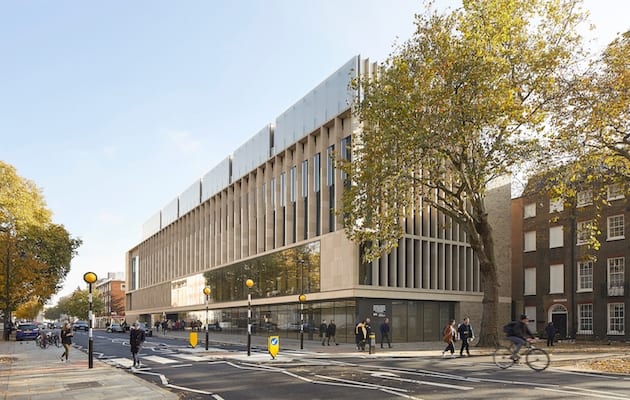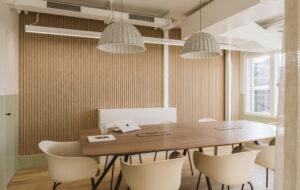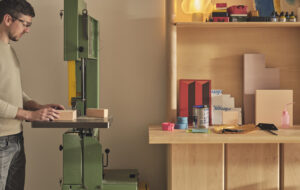 Zayed Centre for Research by Stanton Williams|||
Zayed Centre for Research by Stanton Williams|||
OnOffice: Please tell me how Stanton Williams came to design the Zayed Centre for Research into Rare Disease in Children.
Kalpesh Intwala: Stanton Williams appointed after successfully winning an architectural competition back in 2013.
OO: What did the brief entail?
KI: The client team demonstrated a remarkable level of ambition and innovation in commissioning what is a world first: the first purpose built paediatric centre for research and treatment of rare disease.
Of particular note was the client’s emphasis on producing spaces which, as far as possible, have a non-clinical character and feel calm, warm and welcoming. The aspiration was also to foster collaboration and give expression to the relationship between research and treatment, especially through connection between the research and the paediatric outpatients department.
Read more: Lois O’Hara on being a dreamer, the joy of colour and making others happy
 Exterior facade of Zayed Centre for Research into Rare Disease in Children. Photo: Hufton + Crow
Exterior facade of Zayed Centre for Research into Rare Disease in Children. Photo: Hufton + Crow
OO: Who or what inspired your response to the brief?
KI: Both Stanton Williams and the client were keen to push the boundaries of the conventional clinical design aesthetic and materiality, with the aim being to create legible, warm and natural light filled spaces that would provide a wonderful environment for patients, their families and staff. This is the practice’s first healthcare project and it has allowed us to apply the approach developed in our other work – focussed on the human, experiential qualities of buildings – to the clinical environment.
From the outset we were very interested in the notion of ‘translational research’ (i.e. the virtuous circle between research and patient care), bringing together the various functions within the building while giving them a common identity, and promoting a physical or visual relationship between them.
 Interior of Zayed Centre for Research into Rare Disease in Children. Photo: Hufton + Crow
Interior of Zayed Centre for Research into Rare Disease in Children. Photo: Hufton + Crow
OO: What did you aim to achieve with the project?
KI: We wanted to reimagine the clinical setting while celebrating the often ‘invisible’ work of researchers and clinicians. On this unique site – opposite London’s Coram’s Fields, a space dedicated to the wellbeing of children for over 250 years – we also saw an opportunity to engage healthcare with civic and urban culture through the relationship of the activities within the building to the public realm.
 Passers-by can witness scientists at work as they pass through the building. Photo: Hufton + Crow
Passers-by can witness scientists at work as they pass through the building. Photo: Hufton + Crow
OO: What is your favourite design feature of the building?
KI: The physical and visual relationship between the clinical and research areas works particularly well on many levels, from the entrance bridge over the main research laboratories, the visibility between the functions, the shared material language and the specially commissioned integrated artwork. They appeal to public users and staff alike, for children and adults.
 Grand staircase at the heart of the building. Photo: Hufton + Crow
Grand staircase at the heart of the building. Photo: Hufton + Crow
OO: I find it quite astonishing that this is the world’s first purpose-built centre dedicated to paediatric research into rare diseases. Could you shed some light on why you think governments have not previously invested in such medical infrastructure and what it means to you/ Stanton Williams to have created the first?
KI: We found that similar type of research facilities are often within much larger institutions and hospitals which are not strictly focussed on paediatric research, and funding has more often been directed towards more publicly recognised ‘major’ diseases. As the understanding of rare diseases and technologies has increased substantially over the last few years, specialist paediatric institutions such as Great Ormond Street Hospital and UCL’s Institute of Child Health decided that a dedicated child-focussed ‘ideas factory’ was something that was required and which would benefit from the co-location of specialist scientists who would be able to collaborate and share platform technologies. Stanton Williams is very proud to have been involved in the design and development of this pioneering project.
Read more: NHS England set to transform ExCel London into new makeshift hospital
 Close-up view of staircase. Photo: Hufton + Crow
Close-up view of staircase. Photo: Hufton + Crow
OO: How does this project compare to previous ‘Research’ buildings you have designed/ built?
KI: The Zayed Centre for Research is the third research building that Stanton Williams has completed following the Millennium Seedbank for Kew Gardens and the Stirling Prize winning Sainsbury Laboratory for the University of Cambridge. Although all are research related and share design themes, they are all quite different and respond to very diverse client aspirations, brief requirements and site contexts. However, lessons learnt from each project were built upon in each subsequent project. This ‘cross-fertilisation’ of design ideas is something we use a lot at Stanton Williams, not just within building types but also across typologies.
 Art plays a key part in the design of the centre. Photo: Hufton + Crow
Art plays a key part in the design of the centre. Photo: Hufton + Crow
OO: Generally speaking, what do you consider a successful architectural response to a brief?
KI: A successful architectural response is very much about the holistic approach we bring to projects: understanding the culture of the client, responding to the site and its history, ensuring the building design resolves any contextual complexities, while successfully answering the functional requirements of the brief. Above all, the success of the architectural response will be in the way it supports and enhances the life and activities of those who occupy and engage with the building.
 People passing by at ground level are able to peek inside the centre. Photo: Hufton + Crow
People passing by at ground level are able to peek inside the centre. Photo: Hufton + Crow
OO: Describe the finished building.
KI: It is a generous building that places the human experience at the heart of science and care.
 Stanton Williams have ensured children remain the focus of the building’s design. Photo: Hufton + Crow
Stanton Williams have ensured children remain the focus of the building’s design. Photo: Hufton + Crow
Read more: Ground breaks on Hugh Broughton Architects’ Antarctic research facility
With science currently at the heart of almost every waking discussion, Stanton Williams associate Kalpesh Intwala sheds some light on how to successfully design research centres to combat diseases
























